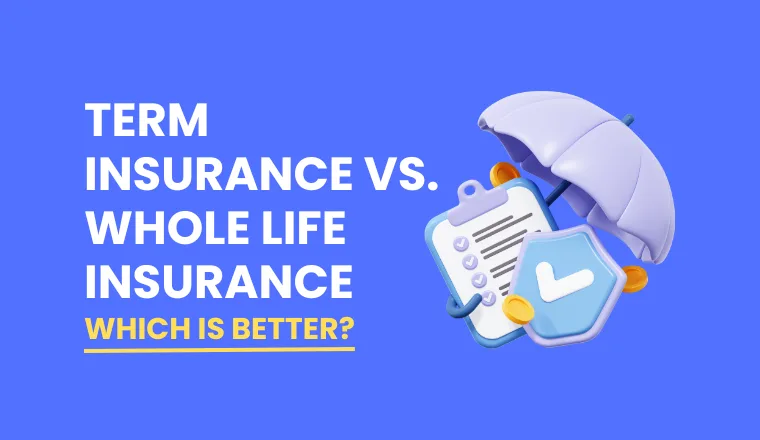

Life insurance is one of the most critical financial tools, offering financial security to your loved ones in case of unexpected events. However, choosing the right type of insurance can be confusing, with two of the most popular options being term insurance and whole life insurance. Both serve different purposes and cater to varying financial needs. This article explores the differences, advantages, and limitations of both options, helping you determine which suits you best.
What Is Term Insurance?
Term insurance is a type of life insurance that provides coverage for a specific period, or “term,” typically ranging from 5 to 40 years. If the policyholder passes away during this period, the insurance company pays a death benefit to the beneficiaries.
- Affordable Premiums: Term insurance plans are generally more affordable than whole life insurance. For example, a ₹1 crore term plan for a healthy 30-year-old can cost as low as ₹5,000 annually.
- No Maturity Benefit: If the policyholder survives the term, no payout is made, making this a pure risk protection plan.
- Customizable Options: Some policies offer add-ons such as critical illness riders, accidental death coverage, or waiver of premium benefits.
Term insurance is ideal for individuals seeking maximum financial protection at minimal cost.
What Is Whole Life Insurance?
Whole life insurance, as the name suggests, provides coverage for the entire lifetime of the policyholder, typically up to 100 years or more. Unlike term insurance, it also includes a savings component that builds cash value over time.
- Lifetime Protection: Whole life insurance ensures that your loved ones receive a death benefit regardless of when you pass away.
- Cash Value Component: A portion of your premium is invested, accumulating cash value that you can borrow against or withdraw.
- Higher Premiums: Premiums are significantly higher than term insurance due to the cash value component and lifelong coverage.
This type of policy is suitable for individuals who seek both financial protection and a long-term savings option.
Key Differences Between Term Insurance and Whole Life Insurance
| Aspect | Term Insurance | Whole Life Insurance |
| Duration | Fixed term (e.g., 20–40 years) | Coverage for life |
| Premiums | Lower premiums | Higher premiums |
| Cash Value | Not applicable | Builds cash value |
| Death Benefit | Paid only during the term | Guaranteed payout |
| Flexibility | Minimal | Allows borrowing against cash value |
| Cost | Affordable | Expensive |
Advantages of Term Insurance
- Cost-Effectiveness: It provides high coverage at a low cost, making it suitable for young individuals or those on a tight budget.
- Simplicity: The plan is straightforward with no complex investment components.
- Focused Protection: Ideal for covering financial liabilities like home loans, children’s education, or other debts.
Advantages of Whole Life Insurance
- Lifelong Security: Provides protection for your entire life, ensuring that your family is always covered.
- Savings and Growth: The cash value acts as a savings tool and grows over time, which can be used during your lifetime.
- Wealth Transfer: Ideal for estate planning, as it ensures wealth transfer to the next generation.
Which should you choose?
Choose Term Insurance If:
- You are looking for affordable, high-coverage protection.
- You have specific financial goals, such as repaying a mortgage or funding children’s education.
- You want to ensure your family’s financial stability in case of your untimely demise.
Choose Whole Life Insurance If:
- You want lifetime coverage and a savings component.
- You have long-term financial goals like wealth creation or estate planning.
- You can afford higher premiums and want a guaranteed death benefit for your heirs.
Blended Approach: Combining Both Plans
Many financial advisors recommend a combination of term and whole life insurance to leverage the benefits of both. For instance, you can use term insurance for short-term financial obligations and whole life insurance for long-term wealth creation and estate planning.
Conclusion
Choosing between term insurance and whole life insurance depends on your financial needs, life goals, and budget. While term insurance provides affordable, straightforward protection for a fixed period, whole life insurance offers lifelong coverage and a savings component at a higher cost. Carefully assess your priorities and consult a financial advisor to make an informed decision.
Both term and whole life insurance are valuable tools for financial security, and the right choice ensures peace of mind and a stable future for your loved ones.
Do check out: How much money do you really need to retire comfortably
FAQ
If you outlive your term insurance policy, no maturity benefits are paid unless you have a return of premium rider, which refunds the premiums paid.
Whole life insurance is worth the premium if you value lifelong coverage and the ability to build cash value as a savings tool.
Some insurers offer convertible term policies, allowing you to switch to whole life insurance without undergoing a medical exam.
Term insurance premiums increase with age, making it less cost-effective for older individuals. Whole life insurance may be a better option in such cases.
Yes, premiums paid for whole life insurance often qualify for tax deductions under Section 80C, and the death benefit is tax-exempt under Section 10(10D) in India.
Yes, you can surrender it, but you may lose part of the cash value and face penalties depending on the surrender terms.




